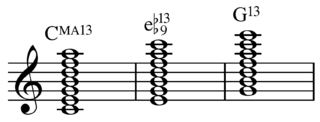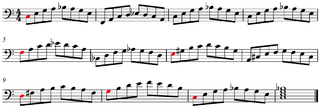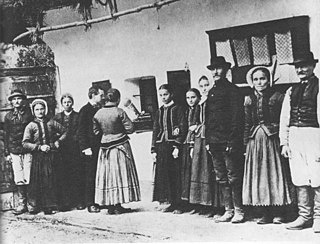The twelve-bar blues is one of the most prominent chord progressions in popular music. The blues progression has a distinctive form in lyrics, phrase, chord structure, and duration. In its basic form, it is predominantly based on the I, IV, and V chords of a key.
Lyrics are words that make up a song usually consisting of verses and choruses. The writer of lyrics is a lyricist. The words to an extended musical composition such as an opera are, however, usually known as a "libretto" and their writer, as a "librettist". The meaning of lyrics can either be explicit or implicit. Some lyrics are abstract, almost unintelligible, and, in such cases, their explication emphasizes form, articulation, meter, and symmetry of expression. Rappers can also create lyrics that are meant to be spoken rhythmically rather than sung.
In jazz and blues, a blue note is a note that—for expressive purposes—is sung or played at a slightly different pitch than standard. Typically the alteration is between a quartertone and a semitone, but this varies depending on the musical context.

In popular music genres such as blues, jazz or rock music, a lick is "a stock pattern or phrase" consisting of a short series of notes used in solos and melodic lines and accompaniment. Licks in rock and roll are often used through a formula, and variations technique in which variants of simple, stock ideas are blended and developed during the solo.
Appropriation in sociology is, according to James J. Sosnoski, "the assimilation of concepts into a governing framework...[the] arrogation, confiscation, [or] seizure of concepts." According to Tracy B Strong it contains the Latin root proprius, which, "carries the connotations not only of property, but also of proper, stable, assured and indeed of common or ordinary." He elaborates: "I have appropriated something when I have made it mine, in a manner that I feel comfortable with, that is in a manner to which the challenges of others will carry little or no significance. A text, we might then say, is appropriated when its reader does not find himself or herself called into question by it, but does find him or herself associated with it. A text is successfully appropriated insofar as the appropriator no longer is troubled with it; it has become a part of his or her understanding, and it is recognized by others as 'owned,' not openly available for interpretation." According to Gloria Anzaldúa, "the difference between appropriation and proliferation is that the first steals and harms; the second helps heal breaches of knowledge."

A ladder of thirds is similar to the circle of fifths, though a ladder of thirds differs in being composed of thirds, major or minor, and may or may not circle back to its starting note and thus may or may not be an interval cycle.
"Gypsy Eyes" or "Gipsy Eyes" is a song written by Jimi Hendrix and performed by the Jimi Hendrix Experience for the 1968 album Electric Ladyland. Subsequently, it was released as the B-side of the "Crosstown Traffic" single, which reached number 52 on the US Billboard Hot 100 and number 37 on the UK Official Singles Chart.
The Gregory Walker or passamezzo moderno was "one of the most popular harmonic formulae in the Renaissance period, divid[ing] into two complementary strains thus:"
Bennett describes the development of recording consciousness, the consequence of "a society which is literally wired for sound" in which, according to Middleton "this consciousness defines the social reality of popular music." "Acoustic instruments and unamplified, 'pure'-tone singing can now not be heard except as contrasts to more recent kinds of sounds, just as live performances are inevitably 'checked' against memories of recordings," and "live performances have to try to approximate the sounds which inhabit this consciousness."
Homologies are "structural 'resonances'...between the different elements making up a socio-cultural whole."
A museme is a minimal unit of musical meaning, analogous to a morpheme in linguistics, "the basic unit of musical expression which in the framework of one given musical system is not further divisible without destruction of meaning." A museme may:
Paradigmatic analysis is the analysis of paradigms embedded in the text rather than of the surface structure (syntax) of the text which is termed syntagmatic analysis. Paradigmatic analysis often uses commutation tests, i.e. analysis by substituting words of the same type or class to calibrate shifts in connotation.
In sociology, articulation labels the process by which particular classes appropriate cultural forms and practices for their own use. The term appears to have originated from the work of Antonio Gramsci, specifically from his conception of superstructure. Chantal Mouffe, Stuart Hall, and others have adopted or used it.
In linguistics, a syntagma is an elementary constituent segment within a text. Such a segment can be a phoneme, a word, a grammatical phrase, a sentence, or an event within a larger narrative structure, depending on the level of analysis. Syntagmatic analysis involves the study of relationships among syntagmas.
A modal frame in music is "a number of types permeating and unifying African, European, and American song" and melody. It may also be called a melodic mode. "Mode" and "frame" are used interchangeably in this context without reference to scalar or rhythmic modes. Melodic modes define and generate melodies that are not determined by harmony, but purely by melody. A note frame, is a melodic mode that is atonic, or has an unstable tonic.
Shout-and-fall or tumbling strain is a modal frame, "very common in Afro-American-derived styles" and featured in songs such as "Shake, Rattle and Roll" and "My Generation".
Repetition is important in music, where sounds or sequences are often repeated. It may be called restatement, such as the restatement of a theme. While it plays a role in all music, with noise and musical tones lying along a spectrum from irregular to periodic sounds,(Moravcsik, 114)(Rajagopal, ) it is especially prominent in specific styles.

In music, a rewrite rule is a recursive generative grammar, which creates a chord progression from another.

Roman Jakobson defined six functions of language, according to which an effective act of verbal communication can be described. Each of the functions has an associated factor. For this work, Jakobson was influenced by Karl Bühler's organon model, to which he added the poetic, phatic and metalingual functions.






